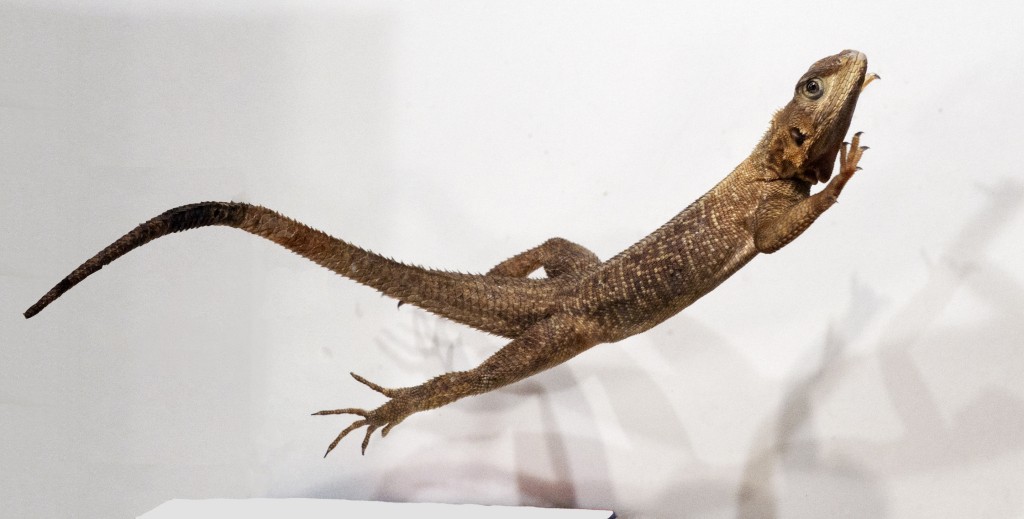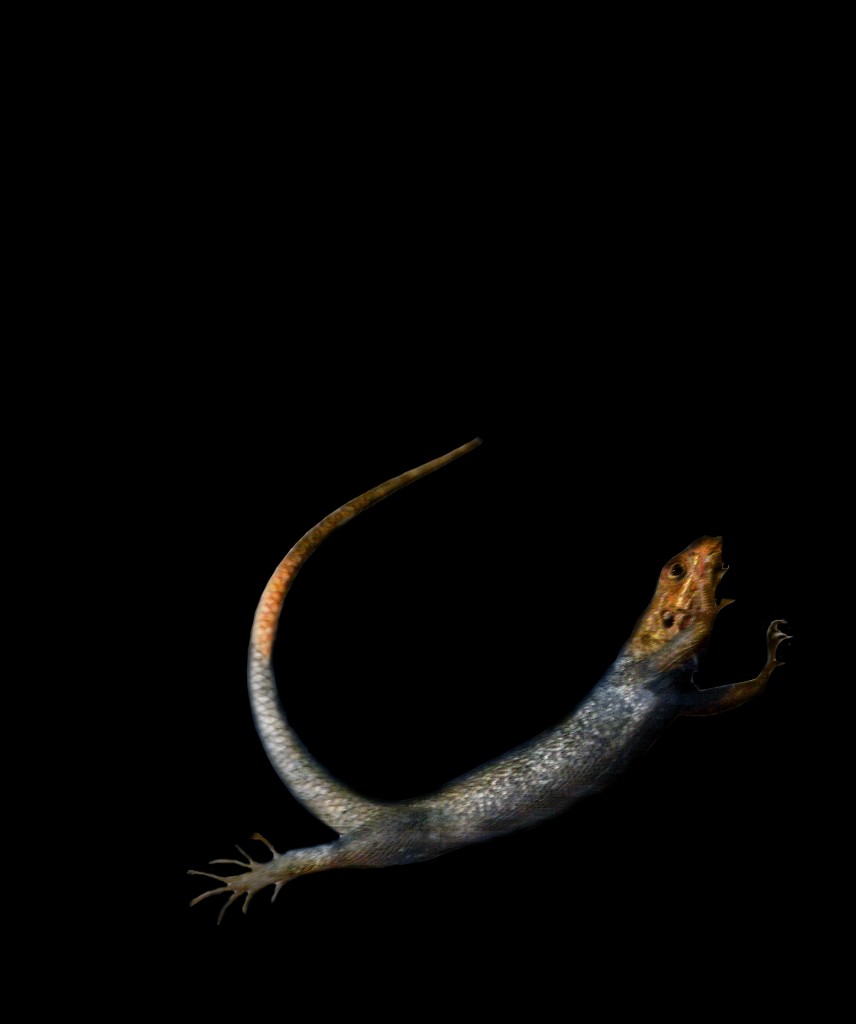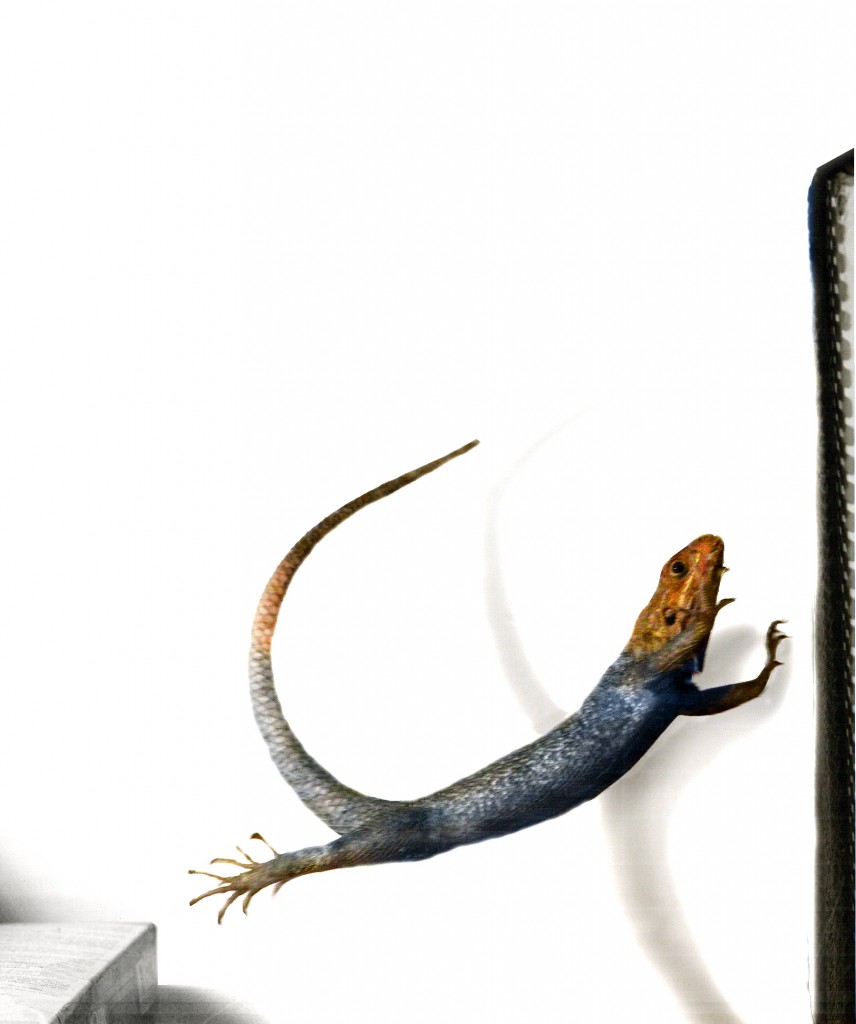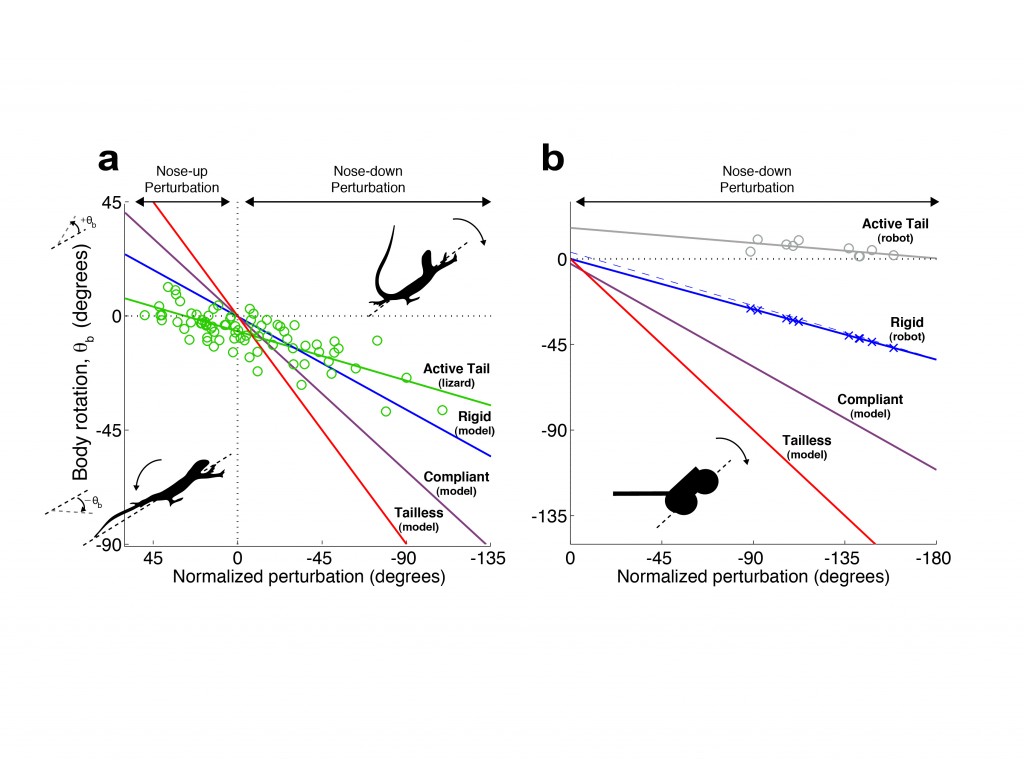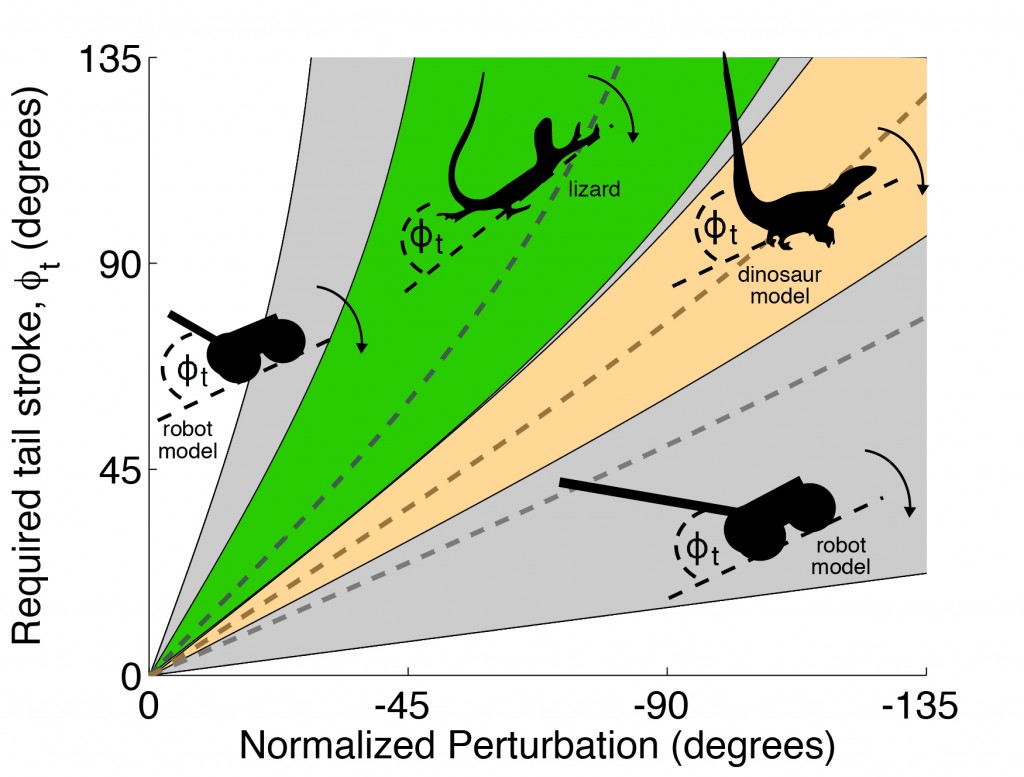Agama Robot Pitch Control
PUBLICITY INFORMATION FOR: Thomas Libby, Talia Moore, Evan Chang-Siu, Deborah Li, Daniel Cohen, Ardian Jusufi & Robert Full. (2012) Tail-assisted pitch control in lizards, robots and dinosaurs. Nature 481, 181–184
THIS IS A PRIVATE WEBSITE. All information is embargoed with immediate effect until 04 January 2012 at 1800 London time / 1300 US Eastern Time. Any access to this information is logged.
SHOULD YOU HAVE REACHED THIS WEBSITE BY ACCIDENT PLEASE CONTACT pauline@berkeley.edu.
Please note: The content of any press release and related material is embargoed with immediate effect until 04 January 2012 at 1800 London time / 1300 US Eastern Time . For more information, see embargo policy of Nature Publishing Group. Wire services stories must always carry the embargo time at the head of each item, and may not be sent out more than 24 hours before that time. For Questions on Embargo Policy contact: Nature Journal. The paper will be published online before being allocated to a print issue and will be citable via a digital object identifier (DOI) number. The DOI for this paper is 10.1038/nature10710. The DOI can be used to retrieve the abstract and full text from the Nature web site by adding it to the following URL: http://dx.doi.org/ .
High Resolution Cover & Figures
Contact Information for Comments
Authors
Thomas Libby. Center for Interdisciplinary Bio-Inspiration in Education and Research, University of California, Berkeley, California 94720-3140, USA. Phone ++1 510 642 0548 e-mail: tlibby@berkeley.edu
Talia Moore. Department of Integrative Biology, University of California at Berkeley, CA 94720-3140. Current address: Department of Organismic and Evolutionary Biology Concord Field Station, Harvard University 100 Old Causeway Road, Bedford, MA 01730 e-mail: tymoore@fas.harvard.edu Phone ++1 781-275-1725
Evan Chang-Siu. Department of Mechanical Engineering, University of California, Berkeley, California 94720-1740, USA. e-mail: evancs@berkeley.edu
Deborah Li. Department of Integrative Biology, University of California at Berkeley, CA 94720-3140 e-mail: d.li@berkeley.edu Phone ++1 510 643 5183
Daniel Cohen. Department of Bioengineering, University of California, Berkeley, California 94720-1762, USA. e-mail: dancohen@berkeley.edu
Ardian Jusufi. Department of Integrative Biology, University of California at Berkeley, CA 94720-3140. e-mail: ardianj@berkeley.edu Phone ++1 510 643 5183
Robert Full. Department of Integrative Biology, University of California at Berkeley, CA 94720-3140. Phone ++1 510 642 9896 (office) or ++510-332-7484 (mobile) e-mail: rjfull@berkeley.edu or robertfullberkeley@gmail.com
Center for Interdisciplinary Bio-inspiration in Education and Research Visit CiBER Center for Learning from Nature
UC Berkeley’s PolyPEDAL Lab Visit
ALL GRAPHICAL MATERIAL (movies, images) IS COPYRIGHTED AND MAY BE USED FOR NEWS PURPOSES ONLY WITH APPROPRIATE CREDIT. ALL MATERIAL FROM THE NATURE ARTICLE AND COVER SHOULD BE CREDITED AS COPYRIGHT NATURE 2012. ALL OTHER MATERIAL SHOULD BE CREDITED AS “Courtesy of PolyPEDAL Lab & CiBER/UC Berkeley” WITH PHOTO CREDIT IF INCLUDED.”
Covers
To view the full-resolution cover, please click on the images above. To download a full-resolution cover, please right-click and save. Photo Credit Thomas Libby, Evan Chang-Siu and Pauline Jennings. Courtesy of PolyPEDAL Lab & CiBER/UC Berkeley
Figures from Paper
COPYRIGHT NATURE 2012. To view Figure 1 as a full-size jpg, please click on the image above. To download Figure 1 as an archived Adobe Illustrator (.ai) file, please click here: Figure1.ai
COPYRIGHT NATURE 2012. To view Figure 2 as a full-size jpg, please click on the image above. To download Figure 2 as an archived Adobe Illustrator (.ai) file, please click here: Figure2.ai
COPYRIGHT NATURE 2012. To view Figure 3 as a full-size jpg, please click on the image above. To download Figure 3 as an archived Adobe Illustrator (.ai) file, please click here: Figure3.ai
Movies from Paper with Compilation of All
Supplementary Video 1 Full_Movie_s1
A side view of a lizard, A. agama, leaping to a vertical surface from a high-friction vault. The animal is not perturbed and the tail angle is held constant. Playback sequences are real time, 4× slowed, and 20× slowed.
Supplementary Video 2 Full_Movie_s2
A side view of a lizard, A. agama, leaping to a vertical surface from a low-friction vault. The animal stabilizes against a nose-down perturbation by swinging the tail, thus redirecting the angular momentum. Playback sequences are real time, 4× slowed, and 20× slowed
Supplementary Video 3 Full_Movie_s3
A side view of the robot driving off an inclined ramp without feedback control. The robot receives a nose-down perturbation, causing both body and tail to rotate. Playback sequences are real time, 4× slowed, and 20× slowed.
Supplementary Video 4 Full_Movie_s4
A side view of robot driving off an inclined ramp with an active tail. The robot receives a nose-down perturbation but transfers angular momentum to the tail angle to hold the body angle constant. The first sequences are real time. Playback sequences are real time, 4× slowed, and 20× slowed.
Supplementary Video 5 Full_Movie_s5
A side view of a lizard, A. agama, leaping to a vertical surface from a high-friction vault. The animal receives a nose-up perturbation and swings the tail down to stabilize the body. The first sequences are real time. Playback sequences are real time, 4× slowed, and 20× slowed.
Compilation Video of All 5 Movies from Paper Full_Compilation_Video
Additional Images and Movies
Images
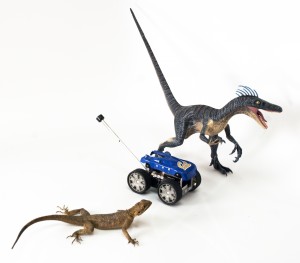
Lizard (Agama agama) with Cal Tailbot Robot and Model Velociraptor (Discovery Channel 4D Anatomy Model, 2008 Fame Master Ent. Ltd.) Photo Credit Thomas Libby, Evan Chang-Siu and Pauline Jennings. Courtesy of PolyPEDAL Lab & CiBER/UC Berkeley
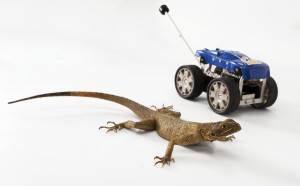
Lizard (Agama agama) with Cal Tailbot Robot. Photo Credit Thomas Libby, Evan Chang-Siu and Pauline Jennings. Courtesy of PolyPEDAL Lab & CiBER/UC Berkeley

Lizard (Agama agama) with Cal Tailbot Robot. Photo Credit Thomas Libby, Evan Chang-Siu and Pauline Jennings. Courtesy of PolyPEDAL Lab & CiBER/UC Berkeley
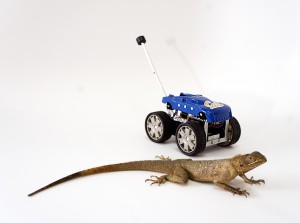
Lizard (Agama agama) with Cal Tailbot Robot. Photo Credit Thomas Libby, Evan Chang-Siu and Pauline Jennings. Courtesy of PolyPEDAL Lab & CiBER/UC Berkeley
Movies
Additional Movie 1. Full_Additional_1
Infrequent hind leg cycling shows that other appendages might contribute to inertial stabilization. A side view of a lizard, A. agama, leaping to a vertical surface from a low-friction vault. The animal stabilizes against a nose-down perturbation by swinging the tail, thus redirecting the angular momentum. Playback sequences is 20× slowed. Courtesy of PolyPEDAL Lab & CiBER/UC Berkeley.
Additional Movie 2. Full_Additional_2
Tail inertial stabilization during running over rough terrain. A side view of a lizard, A. agama, running over rough terrain. The animal slips on a rock and swings its tail up to recent a nose-down pitch. Playback sequence is 20× slowed. (With assistance from Dr. Shai Revzen) Courtesy of PolyPEDAL Lab & CiBER/UC Berkeley.
Additional Movie 3. Tailbot Fall. Full_Additional_3
Experiment demonstrates how an active tail with feedback control on body attitude measurements can be used to perform a self correcting 90 degree body angle in free fall within one body length. Courtesy of CiBER/UC Berkeley.
Additional Movie 4. Tailbot Rough Terrain. Full_Additional_4
Experiment demonstrates how a perturbation that would normally flip a tailless car can be overcome through an active tail and feedback control of the body angle. Courtesy of CiBER/UC Berkeley.
Compilation of Tailbot Additional Movies. Tailbot_Additional_Compilation_Video
Humans with passive tails like large dinosaurs are less maneuverable. Carrier_human_tails
Experiment demonstrating that for large dinosaurs, passive tails can reduce turning performance by 20%. When the human subjects shown in this video ran with the 9.2-fold greater rotational inertia provided by a “tail”, the average velocity through the course decreased to 77%. [Carrier, D. R. et al. Influence of rotational inertia on turning performance of theropod dinosaurs: clues from humans with increased rotational inertia. J. Exp. Biol. 204, 3917–3926 (2001).] Video Courtesy of Professor David Carrier.
From Teaching Lab to Original Research
Information and Photo of Research-based Teaching Laboratory
This study began in a research-based teaching laboratory housed in Berkeley’s CiBER and in part, supported by a NSF Integrative Graduate Education and Research Traineeship Program (IGERT)on Bio- and Bio-inspired Motion Systems Operating in Complex Environments. CiBER’s mission is to facilitate a mutualism where research-based teaching leads to better learning and where interdisciplinary teaching leads to better research. Teams of biologists and engineers composed of both undergraduates and graduate students use state-of-the-art research equipment in the teaching laboratory each week with the opportunity to approach original discovery in areas of biomechanics that include neural control, muscle function, materials testing, energetics, hydrodynamics and aerodynamics. The goal of the final project is to make a novel discovery, present it at a meeting and publish the results. The present study is one such final project and includes, two undergraduate integrative biologists, and four graduate students from integrative biology, bioengineering and mechanical engineering. The study began in the teaching laboratory in the Spring of 2009 examining tail function during running. Another team in the Spring 2010 class picked up the study. In an effort to get more dynamic behaviors to better quantify tail behavior, they explored different obstacle courses. By chance, one student placed a glove box temporarily down on the track and the lizard used it as a vault. Students realized that by varying the surface of the vault, a range of perturbations could be introduced. Several team members completed the final data collection and analysis this year. To date, over a half dozen publications and presentations at national meetings have been generated by the teaching laboratory and several more are in preparation.
Image

Mechanics of Organisms Research-based Teaching Laboratory. Leaping lizard experiment. Left to right - Evan Chang-Siu, Daniel Cohen, Ardian Jusufi, Thomas Libby and Deborah Li. Courtesy of PolyPEDAL Lab & CiBER/UC Berkeley.
Jurassic Park Animators got Physics Right!
The animators of the movie, Jurassic Park, actually got the newly discovered behavior correct in one of the movie’s most dramatic scenes!
When the Velociraptor on the balcony jumps on the T. rex skeleton, it shows the tail up behavior of the leaping lizards that prevents nose down body pitch just as found in the present study.
Media access to clip
Media can license footage.
Go to www.universalclips.com
Register, get a password, and proceed from there.
Direct questions concerning clip access to: Roni Lubliner (NBCUniversal) at roni.lubliner@nbcuni.com
Movie Clip Identification:
Movie: Jurassic Park
Movie
Time stamp: 1:56:10 to 1:56:17
Segment: Hanging on to Die
Description: Velociraptor on balcony to the left of the T. rex skeleton with actors hanging on skeleton.
Velociraptor jumps on T. rex skeleton and shows tail up behavior as in the leaping lizards Nature study to prevent nose down body pitch.
Contact Information for Comments on Article
Professor Kevin Padian – Paleontologist
Department of Integrative Biology
University of California at Berkeley Berkeley, CA 94720
Office Phone 510-642-7434
e-mail kpadian@berkeley.edu
Professor Andrew A. Biewener – Comparative Biomechanics
Concord Field Station, MCZ Harvard University
Old Causeway Road Bedford, MA 01730
Phone: 781-275-1725
e-mail: abiewener@oeb.harvard.edu
Professor Steven Vogel – Comparative Biomechanics & Popular author on Biomimicry
Department of Biology
Duke University, Box 90338 Durham, NC 27708-0338
Phone: (919) 684-3791 (or 2507); home 489-2914
e-mail: svogel@duke.edu
Professor Daniel E. Koditschek – robotics engineer
Alfred Fitler Moore Professor and Chair
Electrical& Systems Engineering
University of Pennsylvania
200 South 33rd Street, Philadelphia, PA 19104-6314
Phone: (215) 898-9506
e-mail: kod@seas.upenn.edu
Professor Mark Cutkosky – robotics engineer
Mechanical Engineering Department
Stanford University
Stanford, California 94305-3030
Phone: (650) 450-0589
e-mail: cutkosky@stanford.edu


